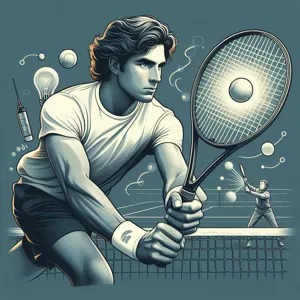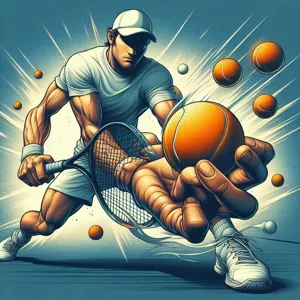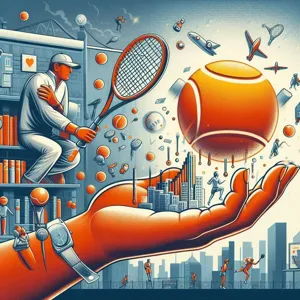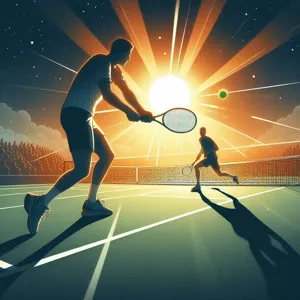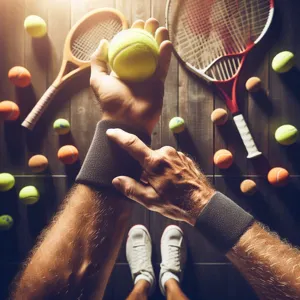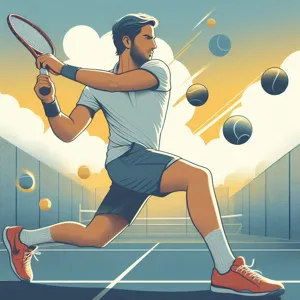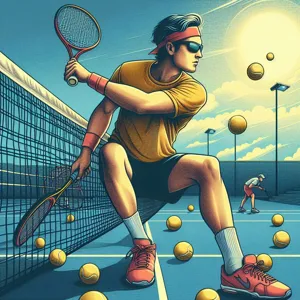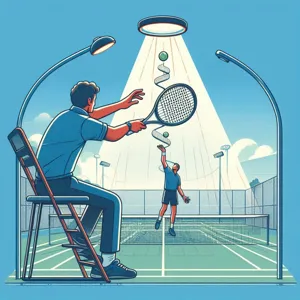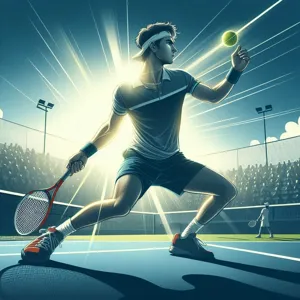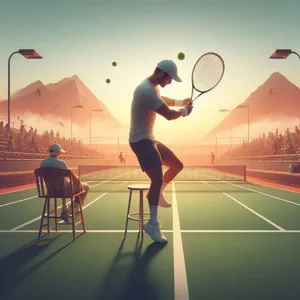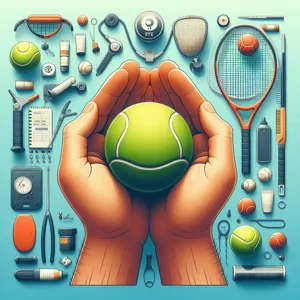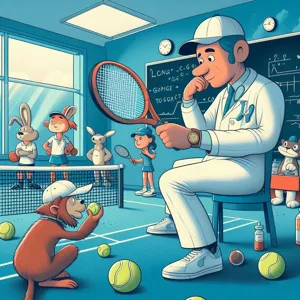Tennis is a sport that demands precision, agility, and strategy, and one of the most exhilarating shots in the game is the smash.
Perfecting this powerful move can be the difference between winning and losing a match, as it allows players to capitalize on their opponent’s mistakes and seize control of the court. Whether you’re a budding enthusiast looking to refine your skills or an experienced player aiming to elevate your game to new heights, mastering the smash is essential. In this blog post, we will explore a selection of top drills designed specifically to enhance your technique, improve your timing, and build your confidence with this dynamic shot. Get ready to take your tennis game to the next level and leave your opponents in awe as you unleash your newfound smashing prowess!
1. Introduction to the Smash in Tennis

The smash is one of the most exhilarating shots in tennis, embodying the perfect blend of power, precision, and tactical finesse. Often regarded as the ultimate finishing move, the smash allows players to capitalize on their opponent’s mistakes, delivering a decisive blow that can turn the tide of a match. Whether you’re a seasoned player or just starting out, mastering the smash can significantly elevate your game, adding a formidable weapon to your arsenal.
At its core, the smash is a vertical shot executed overhead, typically in response to a high ball that has been lobbed over you. The objective is simple: hit the ball with maximum force, sending it crashing down into the opponent’s court, ideally out of their reach. However, the smash is not just about raw power; it requires a keen sense of timing, proper footwork, and an understanding of court positioning.
In this section, we’ll explore the fundamental mechanics of the smash, including grip, stance, and swing technique. You’ll learn how to read the trajectory of the ball and anticipate your opponent’s movements, allowing you to set up for the perfect execution. By honing this critical skill, you can not only improve your overall performance on the court but also instill fear in your opponents, knowing they must defend against your powerful overhead strikes. Get ready to take your tennis game to new heights as we delve into the essential drills and practices designed to master the smash!
2. Importance of a Strong Smash in Your Game
A strong smash can be a game-changer on the tennis court, transforming a defensive rally into an offensive opportunity in an instant. This powerful overhead shot not only showcases your athleticism but also instills fear in your opponents. When executed correctly, a smash can demoralize your rival, send them scrambling, and put you firmly in control of the point.
The importance of mastering the smash goes beyond just scoring points; it’s about dictating the pace and rhythm of the match. A well-timed smash can break the momentum of an opponent, shifting the energy of the game in your favor. It serves as a psychological weapon, reminding your rival of your presence and skill every time they volley back to you.
Moreover, the smash is a critical shot in various match situations — whether you’re closing in on the net after a well-placed volley or responding to a high ball that begs to be put away. It’s a shot that can become a hallmark of your playing style, reflecting your confidence and ability to capitalize on scoring opportunities.
In addition to its offensive prowess, a strong smash can enhance your overall gameplay strategy. It encourages you to adopt a more aggressive playing style, allowing you to seize control of points rather than waiting for your opponent to make a mistake. By incorporating the smash into your arsenal, you elevate not just your individual performance but also your team dynamics in doubles play, as your strong overhead can complement your partner’s game.
Ultimately, investing time in refining your smash can lead to significant improvements in your overall game. With the right drills, you can ensure that this powerful shot becomes a reliable weapon in your tennis toolkit, ready to propel you to victory in critical match moments.
3. Understanding the Mechanics of a Perfect Smash

The smash is one of the most exhilarating shots in tennis—a powerful strike that can turn the tide of a match in an instant. But to truly master this shot, players must first grasp the underlying mechanics that make a perfect smash possible. Understanding these mechanics not only enhances your technique but also instills a sense of confidence when the opportunity arises to deliver that game-changing blow.
To begin with, positioning is key. As the ball approaches, your feet should be shoulder-width apart, allowing for proper balance and stability. The ideal stance involves slightly bending your knees and keeping your weight on the balls of your feet, ready to spring into action. As you track the ball, make sure to use your non-dominant hand to point toward it, helping you gauge its trajectory and prepare for your swing.
Once in position, it’s essential to focus on your grip and racket angle. A continental grip is often recommended for a smash, as it allows for both power and control. As you prepare to strike, raise your racket above your head, keeping your elbow bent and your wrist firm. The angle of your racket face should be slightly open, creating the ideal conditions for a clean, powerful hit.
Timing is another crucial aspect of executing a successful smash. As the ball reaches its apex, you should initiate your swing. Engage your core and use your legs to propel yourself upward, generating upward momentum. The follow-through is equally important; extend your racket fully after contact, allowing your arm to complete a natural arc. This not only adds power to your shot but also helps maintain control.
Finally, don’t underestimate the mental aspect of the smash. Visualize the shot before it happens, anticipating where you want the ball to land. This mental preparation, coupled with physical practice, will ensure that when the moment comes, you’re not only ready but also confident in your ability to execute a perfect smash. By understanding and practicing these mechanics, you’ll elevate your game and leave your opponents awestruck as you deliver breathtaking volleys from above.
4. Essential Equipment for Practicing Smashes
To truly master the smash, having the right equipment is just as crucial as practicing the technique itself. Whether you’re a beginner just starting out or an advanced player looking to refine your skills, investing in the right tools can make all the difference in your training sessions.
**1. Tennis Racket:** The most fundamental piece of equipment is, of course, your racket. Look for a racket that is lightweight yet sturdy, offering a good balance between power and control. A racket with a larger head size can provide a larger sweet spot, making it easier to connect with the ball during practice. Many players prefer rackets that have a good grip and are designed specifically for power shots, which is essential for executing a powerful smash.
**2. High-Quality Tennis Balls:** The type of tennis balls you use can greatly affect your practice experience. Opt for high-quality, durable balls that maintain their bounce over time. Consider using practice balls that are specifically designed for drills, as these tend to have a consistent performance, allowing you to focus on perfecting your technique without the distraction of erratic ball behavior.
**3. Training Aids:** Incorporating training aids into your practice can help elevate your smash game. Consider using a ball machine or a rebounder to practice your timing and footwork. These tools allow you to hit numerous balls in succession, helping you develop muscle memory and precision. Additionally, a hitting target can help you focus on accuracy, ensuring that you’re not only smashing the ball but also placing it strategically on the court.
**4. Court Shoes:** Don’t underestimate the importance of proper footwear. Court shoes designed for tennis provide the necessary support and traction to help you move swiftly and safely on the court. A good pair of shoes will enhance your stability during explosive movements, which is crucial for executing a powerful smash. Look for shoes that offer cushioning and lateral support, allowing you to pivot and spring into action without fear of slipping.
**5. Practice Partner:** Lastly, while not a physical piece of equipment, having a reliable practice partner can significantly enhance your training sessions. A partner can feed you balls, challenge you to improve your accuracy, and provide constructive feedback. Plus, practicing with someone else adds an element of fun and competition, keeping your motivation high.
Equipped with the right gear and resources, you’ll be well on your way to mastering the smash. Remember, consistent practice with the proper equipment will lead to improvement, enhancing both your confidence and your performance on the court. So gear up, hit the courts, and get ready to elevate your game!
5. Warm-Up Drills to Prepare for Smashing

Before diving into the intensity of smashing drills, it’s crucial to properly warm up your body. Warming up not only helps prevent injuries but also enhances your performance on the court. Here are some effective warm-up drills designed to get your muscles ready for those explosive smashes.
**Dynamic Stretching**: Start with a series of dynamic stretches to activate your muscles and increase blood flow. Focus on your shoulders, arms, and legs—key players in executing a powerful smash. Arm circles, leg swings, and torso rotations are excellent choices. Spend about 5-10 minutes on this, gradually increasing the range of motion for each movement.
**Shadow Swings**: Once your body feels loose, move on to shadow swings. Without a ball, practice your smashing motion, focusing on your footwork, body positioning, and follow-through. Pay attention to your grip and ensure that your non-dominant hand is aiding in the swing. This drill helps reinforce muscle memory and sets a solid foundation for when you hit the court.
**Footwork Drills**: Smashing is as much about footwork as it is about technique. Incorporate footwork drills such as lateral shuffles and quick sprints to improve your agility. Set up cones or markers on the court and practice moving quickly between them, mimicking the movements you’ll need to make when approaching the net for a smash.
**Ball Toss Drills**: To simulate the smashing motion more closely, practice tossing the ball into the air with your dominant hand and preparing to swing as if you were hitting a smash. Focus on timing and rhythm, ensuring that you make contact at the highest point possible. This not only warms up your shoulder and arm but also helps you get accustomed to the feel of the swing.
**Reaction Drills**: Finally, engage in some reaction drills with a partner or a coach. Have them toss balls at varying heights and speeds, encouraging you to react quickly and adjust your positioning accordingly. This will not only warm up your muscles but also sharpen your reflexes, preparing you for the unpredictability of a real match.
By incorporating these warm-up drills into your routine, you’ll ensure that your body is primed for smashing, allowing you to execute those powerful shots with confidence and precision. So, before you step onto the court, take the time to warm up properly—it’s the first step to mastering the art of the smash!
6. Footwork Drills to Enhance Positioning
When it comes to mastering the art of the smash in tennis, footwork is often the unsung hero of a powerful and effective shot. Without the right positioning, even the strongest player can fall short of executing a perfect smash. Footwork drills are essential for improving your movement on the court, ensuring you’re in the ideal spot to unleash your powerful overhead shots.
One effective drill to enhance your footwork is the **Ladder Drill**. By using an agility ladder, you can focus on quick, precise movements that will improve your foot speed and coordination. Start by placing the ladder flat on the ground and practice various foot patterns, such as lateral shuffles or single-leg hops, moving through the rungs as quickly as possible. This exercise not only builds speed but also helps you develop the agility needed to reposition yourself quickly during a match.
Another valuable drill is the **Cone Drill**. Set up a series of cones in a zigzag pattern on the court and practice sprinting from one cone to the next, working on both your forward and lateral movements. This drill mimics the unpredictable nature of a game, helping you become comfortable with rapid direction changes. Focus on maintaining a low center of gravity and using short, quick steps to maintain balance as you approach each cone, simulating the movement required when preparing for a smash.
Lastly, don’t overlook the importance of shadowing your shots. Stand at the baseline and visualize an opponent’s shot coming toward you. As you move to intercept the imaginary ball, practice your footwork and positioning. This drill helps reinforce muscle memory and prepares you to react instinctively during actual play.
Incorporating these footwork drills into your training routine will not only boost your overall agility but will also position you perfectly for those critical moments on the court. With improved footwork, you’ll find that your smashes become more powerful and more accurate, giving you the edge you need to dominate your matches.
7. The Toss: Perfecting Your Ball Placement

The toss is often the unsung hero of a successful serve in tennis, yet mastering it can significantly elevate your game. An accurate toss sets the foundation for a powerful and precise serve, and understanding its mechanics is crucial for players at all levels.
To perfect your ball placement, start by establishing a consistent toss height. Ideally, the ball should be released at a height that allows you to make contact at the apex of your swing. For many players, this means tossing the ball slightly in front of your body and at the height of your outstretched arm. A good rule of thumb is to aim for a toss that’s around a foot above your intended contact point.
Next, consider the angle of your toss. A common mistake is tossing the ball too far to the side or back, which can lead to awkward positioning and decreased power. Instead, focus on a straight vertical toss, maintaining a consistent trajectory that allows you to strike the ball cleanly. Practicing your toss without hitting serves can help develop this muscle memory—stand at the baseline and toss the ball up repeatedly, ensuring that each placement is identical.
Another vital component is your grip and stance. Your grip should feel comfortable and secure, while your stance should be balanced and ready to pivot. As you toss the ball, keep your eyes focused on it, allowing you to track its movement and make any necessary adjustments. This awareness will not only enhance your confidence but also improve your timing as you prepare to strike.
Finally, incorporate drills that emphasize your toss. Set up a target area on the court to aim for with your toss and practice consistently until you can consistently land the ball in that zone. This can be done with a partner who can feed balls to you after you toss, or simply by practicing your serve against a wall.
Perfecting your toss may seem like a small detail, but it can be the difference between a strong, confident serve and a frustrating miss. By focusing on your toss, you’re laying the groundwork for a more effective serve and ultimately taking your tennis game to new heights.
8. Top Drills for Practicing the Overhead Smash
The overhead smash is one of the most powerful shots in a tennis player’s arsenal, often marking the turning point in a match. To master this formidable move, incorporating specific drills into your practice routine is crucial. Here are some top drills designed to refine your technique, boost your confidence, and elevate your tennis game.
**1. Shadow Swings:** Start by visualizing the ball being served high above you without any actual ball involved. Stand in your ready position, pivot into your backswing, and practice your overhead motion in slow motion. Focus on your footwork, body rotation, and follow-through. This drill helps build muscle memory without the distraction of a ball.
**2. Partner Toss Drill:** Team up with a partner who can assist you in honing your overhead smash. Have them toss the ball high into the air, aiming directly in your hitting zone. As you anticipate the toss, position yourself under the ball, use your non-dominant hand to guide it, and execute your overhead smash. This drill emphasizes timing and positioning, critical elements for a successful smash.
**3. Target Practice:** Set up targets on the court—these could be cones, towels, or specific areas marked with tape. Have your partner or coach feed you balls that you must smash towards these targets. This drill not only enhances your accuracy but also encourages you to vary your shot placement, making you a more versatile player.
**4. Reaction Drills:** Overheads often come in response to a lob, so practicing your reaction time is essential. Have a partner stand at the opposite baseline and lob balls to you at varying heights and angles. This drill will help you develop quick reflexes and the ability to assess the situation rapidly, ensuring you’re always ready to execute that powerful smash.
**5. Wall Practice:** If you’re practicing alone, find a solid wall where you can hit against. Stand a few feet away and hit overhead smashes against the wall, focusing on your form and follow-through. This drill allows you to work on your timing and technique repeatedly without needing a partner.
Incorporating these drills into your routine will not only improve your overhead smash but also instill a greater sense of confidence during matches. Remember, consistency is key—dedicate time to these drills, and you’ll find that mastering the smash is within your reach!
9. Incorporating Target Practice into Your Drills
Incorporating target practice into your drills is an essential step in elevating your tennis game to new heights. It’s not just about hitting the ball back and forth; it’s about honing your precision and accuracy, which are vital skills for any competitive player. Target practice transforms your routine from mere repetition into a focused exercise that sharpens your aim and enhances your overall court strategy.
To begin, set up targets at various points on the court. You can use cones, hula hoops, or even specialized targets designed for tennis training. Position them in the corners of the service box, along the baseline, or at the net to simulate real match scenarios. As you practice, aim to hit these targets consistently, adjusting your stance and swing to improve your accuracy.
Start with stationary targets, then progress to moving targets as you become more comfortable. This could involve a partner who volleys balls back to you while you aim for specific spots. Incorporating movement into your target practice not only challenges your footwork but also mimics the dynamic nature of a real match, preparing you for the unpredictable nature of your opponent’s shots.
Additionally, keep track of your progress. Create a scoring system based on how many targets you hit within a set time frame or during a particular number of rallies. This adds an element of competition and motivation to your practice, pushing you to improve with each session.
By regularly integrating target practice into your training regimen, you’ll develop a sharper eye and a more strategic mindset. Over time, you’ll find that your confidence on the court skyrockets, allowing you to place shots with precision and put your opponent on the defensive, ultimately leading to more wins and a deeper understanding of the game.
10. Partner Drills for Real-Game Scenarios
When it comes to refining your tennis skills, nothing beats the dynamic energy of partner drills that simulate real-game scenarios. These drills not only enhance your individual technique but also help you develop the crucial ability to read your opponent’s moves and respond effectively under pressure. Engaging with a training partner allows for a more interactive experience, fostering communication and strategic thinking that you might not achieve while practicing solo.
One effective drill to start with is the **Cross-Court Rally**. Set up a game where you and your partner rally back and forth, focusing on hitting the ball cross-court. This emphasizes accuracy and consistency, pushing you to improve your shot placement while also forcing you to cover the court efficiently. As you grow more comfortable, challenge yourselves by mixing up the pace and spin of your shots, simulating different match situations.
Next, try the **Volleys and Lobs Drill**. Stand at the net and have your partner hit groundstrokes to you from the baseline. Your objective is to volley the ball back, forcing your partner to adjust their position and respond with either a lob or a passing shot. This drill sharpens your reflexes and sharpens your net play while also providing invaluable practice in anticipating your partner’s next move.
For a more competitive edge, incorporate a **Point-Play Drill**. Set up points by starting with a serve or a feed from the baseline. Play out the points just as you would in a match, focusing on strategic play rather than just winning. This can include practicing your serve and return strategies, which can be tailored based on your opponent’s strengths and weaknesses.
Finally, don’t forget to add a **Game Scenario Drill** where you simulate specific match situations, such as playing in a tiebreaker or defending against a break point. This not only helps you practice your mental toughness but also reinforces your ability to perform under pressure, a critical aspect of competitive tennis.
By integrating these partner drills into your training regimen, you’re not just honing your skills in isolation; you’re preparing yourself for the unpredictability of real matches. The synergy of practicing with a partner will elevate your game, providing the necessary experience to master the art of tennis.
11. Analyzing Professional Players’ Smashes
Analyzing professional players’ smashes can provide invaluable insights that can elevate your own game. Watching the best in the sport, such as Rafael Nadal or Serena Williams, execute their smashes is not just about admiring their power; it’s about understanding the technique and strategy behind each movement.
Start by focusing on their footwork—notice how they position themselves to the ball, ensuring they are balanced and ready to generate maximum power. Professionals often use a combination of lateral quickness and explosive upward movement, allowing them to reach high balls with grace and precision. Pay attention to their grip as well; many pros utilize the continental grip for smashes, which facilitates a strong, versatile finish.
Next, observe their swing mechanics. The fluid motion from preparation to follow-through is a dance of coordination and timing. Watch how they lead with their non-dominant hand, opening their body to generate torque, before unleashing the racket head with incredible speed. This technique not only adds power but also enhances control over the placement of the shot.
Finally, consider the mental aspect: professional players often exhibit a calm confidence when executing their smashes. They assess their position on the court, the opponent’s location, and the trajectory of the ball before committing to the shot. This level of situational awareness is crucial; it’s what separates an average smash from a game-changing one.
To effectively incorporate these insights, consider recording your own practice sessions. Compare your technique with the pros, identifying areas for improvement in footwork, grip, swing, and mental focus. By analyzing professional players’ smashes and integrating those lessons into your practice, you’ll not only enhance your skills but also develop a deeper appreciation for the artistry of the game.
12. Mental Strategies for Building Confidence in Your Smash
When it comes to mastering the smash in tennis, physical prowess alone isn’t enough; the right mental strategies can make all the difference in elevating your game. Building confidence in your smash requires a focused mindset that turns potential anxiety into assertiveness. Here are some effective mental strategies to consider:
**Visualization Techniques:** Before stepping onto the court, take a few moments to visualize yourself executing the perfect smash. Imagine the ball soaring through the air, the sound of your racket making solid contact, and the triumphant feeling of scoring a point. This mental rehearsal can create neural pathways that enhance your physical performance, making the act of smashing feel more familiar and achievable.
**Positive Self-Talk:** Replace negative thoughts with empowering affirmations. Remind yourself of previous successful smashes and the hard work you’ve put in to hone your skills. Phrases like “I have the strength and technique to nail this shot” or “I trust my training” can help reinforce a confident mindset during matches.
**Mindfulness and Presence:** Practice mindfulness techniques to stay present in the moment. Rather than dwelling on past mistakes or worrying about future points, focus on the current play. Engaging fully with each rally can reduce anxiety and enhance your overall performance, allowing you to approach the smash with clarity and confidence.
**Set Small Goals:** Instead of overwhelming yourself with the pressure of perfection, break your skill development into achievable goals. Focus on mastering one aspect of your smash at a time, whether it’s your footwork, timing, or follow-through. Celebrating these small victories can build your confidence incrementally, leading to a more assured overall performance.
**Embrace Mistakes:** Understand that mistakes are a natural part of the learning process. Rather than viewing them as failures, treat them as opportunities to learn and grow. Embracing a growth mindset will help you bounce back from errors with resilience, ensuring that your confidence remains intact, even when the game doesn’t go as planned.
By incorporating these mental strategies into your training routine, you’ll not only improve your smash but also cultivate a resilient mindset that empowers you to perform your best under pressure. Remember, confidence is not just about skill; it’s about believing in yourself and your ability to rise to the occasion, game after game.
13. Common Mistakes and How to Avoid Them
Mastering the smash in tennis can be a thrilling endeavor, but it’s important to recognize that even the most experienced players can fall into the trap of common mistakes. Understanding these pitfalls is the first step in mastering this powerful shot and elevating your game to new heights.
One of the most frequent errors players make is failing to properly position themselves beneath the ball. A strong smash begins with excellent footwork, so always strive to get into position early. If you find yourself reaching for the ball awkwardly or taking off-balance swings, you’re likely sacrificing power and accuracy. To avoid this, practice your footwork drills to enhance your agility and ensure you’re in the optimal position to strike.
Another common mistake is over-swinging. It’s easy to get caught up in the excitement of hitting a powerful shot, but too much force can lead to loss of control. Instead, focus on maintaining a smooth, fluid motion. Visualize the ball’s trajectory and concentrate on striking it cleanly rather than simply trying to hit it as hard as possible. Incorporating drills that focus on technique over power will help you develop a more controlled smash.
Moreover, many players neglect to follow through after making contact with the ball. A proper follow-through not only adds more spin and depth to your shot but also helps you prepare for the next move. Practice your smash with an emphasis on completing your swing and transitioning smoothly into your next position on the court.
Lastly, don’t overlook the mental aspect of the game. Anxiety or pressure can cause players to rush their smashes or second-guess their shot selection. To combat this, engage in visualization techniques and mindfulness exercises that allow you to focus on the moment, keeping your composure even in high-stakes situations.
By recognizing these common mistakes and actively working to avoid them, you can transform your smash from a hit-or-miss shot into a reliable weapon in your tennis arsenal. Remember, improvement comes with practice and a keen awareness of your game—so keep refining your technique, and soon enough, you’ll be smashing your way to victory!
14. Tracking Your Progress: Tips for Improvement
Tracking your progress is an essential component of mastering your tennis game. Improvement doesn’t happen overnight, but with dedication and the right approach to monitoring your development, you can see significant strides in your skills and overall performance. Here are some effective tips for tracking your progress and ensuring continuous improvement.
First and foremost, consider maintaining a detailed training journal. In this journal, document each practice session, noting the drills you performed, the techniques you focused on, and any specific goals you aimed to achieve. Recording your thoughts will not only help solidify your learning but also allow you to reflect on your progression over time. Include metrics such as the number of successful serves, forehands, or backhands you executed, as well as any challenges you faced. This will give you clear benchmarks to measure against in future sessions.
In addition to your training journal, leverage technology to your advantage. Many tennis apps and wearable devices can track your performance metrics, such as ball speed, shot accuracy, and court coverage. These tools can provide valuable insights into your strengths and weaknesses, allowing you to make informed adjustments to your training regimen. For example, if your app reveals that your serve speed has plateaued, it might be time to focus on specific drills that enhance your serve technique and power.
Another effective method for tracking your progress is to set specific, measurable goals. Whether you aim to improve your serve percentage, reduce unforced errors, or enhance your footwork speed, having clear objectives will give your practice sessions purpose and direction. Break these goals down into smaller, achievable milestones, and celebrate your successes along the way. This not only keeps you motivated but also helps you see the tangible results of your hard work.
Finally, don’t underestimate the power of feedback. Consider working with a coach or a more experienced player who can provide constructive criticism on your technique and strategy. Regularly seeking input from others can illuminate areas for improvement that you may not recognize on your own. Additionally, video analysis can be a powerful tool; recording your matches or practice sessions allows you to visually assess your performance and make necessary adjustments.
By implementing these tracking methods, you create a structured approach to your improvement, ensuring that every practice session brings you one step closer to mastering the smash and elevating your overall tennis game. Progress is a journey, and with the right tools and mindset, you’ll find yourself continuously growing and excelling on the court.
15. Conclusion: Integrating the Smash into Your Overall Game Strategy
In conclusion, mastering the smash is not just about perfecting a single stroke; it’s about integrating this powerful shot into your overall game strategy to elevate your tennis performance. The smash can be a game-changer, creating opportunities to win points and assert dominance on the court. However, its effectiveness hinges on your ability to seamlessly incorporate it with your other skills, such as footwork, positioning, and shot selection.
As you practice the drills outlined in this guide, focus on how the smash complements your baseline game and net play. Work on your awareness of when to execute the smash—recognizing high balls that are ripe for the taking can make all the difference. Additionally, consider how your opponents play; understanding their tendencies will allow you to anticipate moments when a well-timed smash can turn the tide in your favor.
Moreover, don’t overlook the mental aspect of the game. Confidence in your smash will come from repeated practice, so maintaining a positive mindset is crucial. Visualize successful smashes during your training sessions, and remind yourself that every practice is an opportunity to sharpen this valuable skill.
Remember, tennis is a dynamic sport, and the best players are those who can adapt and adjust their strategies. By integrating the smash into your overall game plan, you not only enhance your arsenal of shots but also develop a more aggressive and unpredictable style of play. So, step onto the court with confidence, let your smash shine, and watch as you transform your game into one that keeps your opponents on their toes. Happy smashing!
In conclusion, mastering the smash is not just about power; it’s about precision, timing, and strategy. By incorporating the top drills we’ve outlined in this post into your practice routine, you’ll develop the skills and confidence needed to elevate your tennis game to new heights. Remember, consistent practice and a focused mindset are key to transforming your smashes into game-changers on the court. So grab your racket, hit the courts, and watch as your opponents struggle to return your powerful strikes. We can’t wait to hear about your progress and how these drills have impacted your performance. Keep smashing it!


